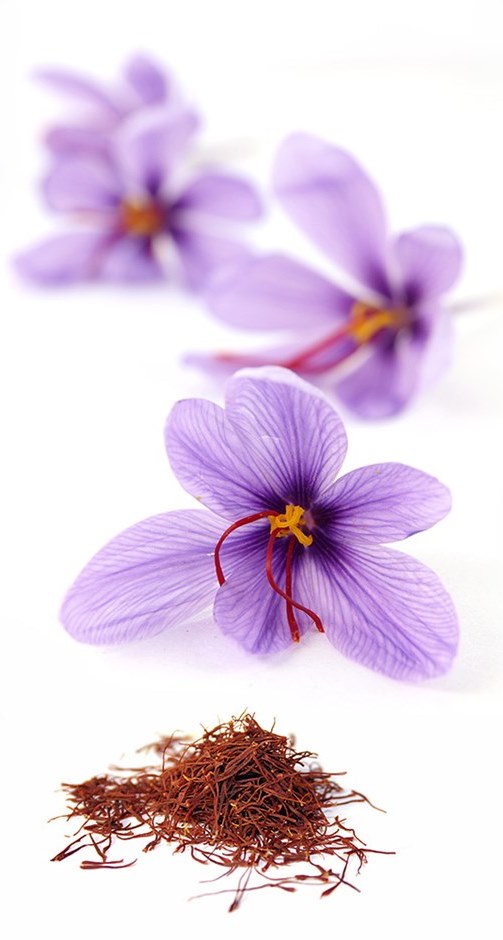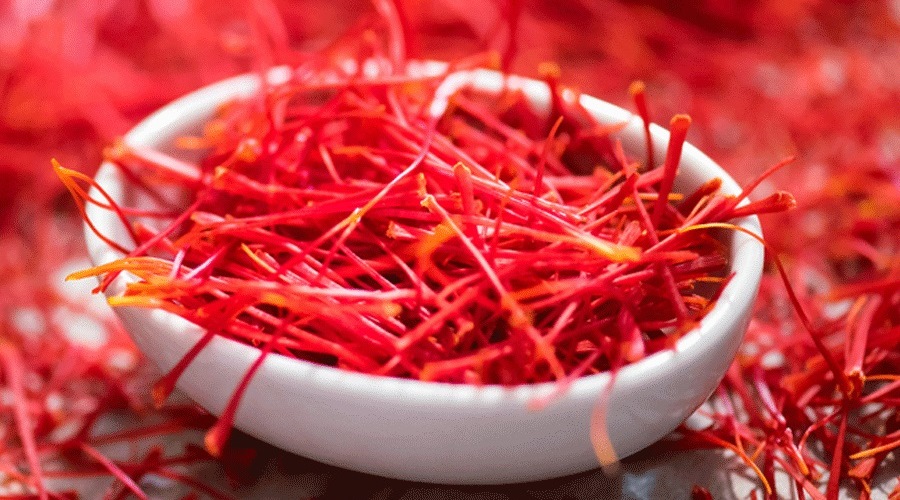What is Saffron? Saffron spice is a very precious spice rich of antioxidant with total housekeeping benefits that will give your body a total cleanse from head to toe. You will know the real essence and meaning of “wellness” and felling good the moment saffron spice becomes a part of your every day cooking.
Saffron Spice Filaments
The threads or filaments of saffron spice are dried stigmas of Crocus Sativus Linnaeus. Every flower only has 3 stigmas. These threads should be hand- picked from every flower, and more than 70,000 of these is required in producing just 1 pound of saffron filaments, making it the most valuable spice in the world. However, due to saffron’s intense flavor and strong coloring power, it must be used carefully.
Saffron spice gives any food intense flavor, revitalizing aroma and bright orange-yellow color.
Crocus Sativus Linnaues, the scientific name of saffron flower, contains a substance known as crocin. This is responsible for saffron’s revitalizing aroma, intense flavor, strong coloring property and therapeutic properties. Saffron spice is available both in powder and filaments, though the long, red filaments are typically preferable to the powder, as the latter can be adulterated.
Saffron – Its Origin and History
It is believed that saffron is a native to middle east, Asia Minor and Mediterranean area. However, it is in middle east where it has been originally cultivated. Later on, it was taken to other parts of the world due to the barter trade.
Saffron Legends and Facts:
- According to legends, saffron was brought to India with the descent into the world and later on, was take to Kashmir in order to be cultivated and applied in several fields.
- The oldest surviving document with regard to saffron’s application originally belongs to the ancient dynasty of Iran. Achaemenids engraved an inventory on a pillar including the quantity and variety of foods items that were utilized in the palace kitchen, and saffron is one of the items mentioned. The Achaemenids also used saffron in cosmetic products due to its skin.
- With saffron’s bitter taste and exotic aroma, it was named among the sweet smelling herbs in the Song of Solomon.
- A golden-colored water soluble dye for fabric was extracted from the stigmas of saffron in India during the ancient times. After the death of Buddha, his priests made saffron the official shade of their robes. The dye has also been utilized for royal raiment in various cultures.
- Saffron was also used as a perfume. It was sprinkled in Roman and Greek balls, theaters, courts and halls. Not long, it became linked with the hetaerae, a proficient class of courtesans in Greece. The roman streets were also strewn with saffron when Nero entered the city.
- When the Muslims conquered Spain, some items cultivable in areas under Muslim influence were taken there in AD.
- Saffron is mentioned in an English healing manual also known as English leechbook in the 10th century.
- Saffron is also said to have been brought to China by the Mongols who took its bulb from the Iranian soil. It is recorded in PunTsaou, a Chinese material media (1552-78).
Scientific Facts of Saffron

Saffron Flower and Threads
Saffron’s Scientific Name: Crocus Sativus Linnaeus
Species: Iridacean
Family: Corm
Thecorm of saffron isa perennial, stem less, plant that just has a few years lifespan. From every corm in fall, 1 or 2 flowers is grown (rarely more than 2). These purple-colored flowers contain only 3 red-colored stigmas that are very precious.
The chemical constituents found in the stigmas of saffron are color pigments such as zeaxanthin, lycopene, beta carotene, alpha carotene and crocin, vitamins such as thiamine and riboflavin, picrocrocin, safranal, mucilage, minerals and carbohydrates.
Saffron also has anthocyanin pigments and free aglyconecrocin. Crocin, an unusual car
otenoid that is found in nature is by far the most dominant chemical in saffron’s coloring property. It can easily be dissolved in water,
Picrocrocin is a glucose that is responsible for saffron’s bitter taste. In order to produce safranal, this glucose undergoes crystallization through a process known as acid hydrolysis.
Safranal is the major aromatic substance, making up 60% of the composition of saffron’s unstable components. It is a gelatinous liquid that produces a bright yellow blemish when exposed to steam. It can also be dissolved in petroleum, ether, methanol and ethanol.
Saffron Harvest and Gathering
Cultivation of saffron is done on a recurring basis, and that after 7-9 years lapse, the land in questions must be switched to another type of crop like grains for a period of 7 years so that the soil can replenish its lost nutrients.
The flowers of saffron are manually harvested in mid-fall. The harvest time depends on environmental and agricultural conditions and it also takes up to 20 days.
Harvest Time: Flowers are hand-picked early in the morning, as the temperature is low and the saffron flowers are still shut, thereby decreasing the chances of mechanical damage stimulation and contamination at the harvest time. The gathering and transfer of the flowers is done in dry baskets made of either plastic or straw.
Transfer: The transfer of saffron flowers is done in such a way that contamination or mechanical damage is prevented. Thus over piling of flowers and putting too much pressure on them during the transfer and transport process is avoided.
Separation: Saffron is gathered in filaments and is stored within clean and dry containers. The later the separation of saffron’s filament from the flower, the higher the quality acquired.
Drying Saffron: To effectively preserve saffron, it must be completely dried. The exceptional aroma of saffron is caused by the picrocrocin’s hydrolysis and the safranal’s release. The ways on how to dry saffron are the following:
- Spanish Method
- Traditional Persian Method
- Industrial Method: This method has 3 types of drying systems:
- Vacuum dryers
- Belt dryers
- Air flow dryer
What are the Uses of Saffron?
Medicinal: Saffron is rich in Riboflavin and Vitamin B2. It is claimed to have potential of having many health benefits.
Cosmetic: During the ancient times, royalty and wealthy women utilized saffron as a facemask in order to soothe rashes and remove acne and pimples. Saffron is also anti-allergic and is widely utilized in the cosmetic industry.
Cooking: Saffron is an irreplaceable spice in both national and international dishes. Due to its superb coloring and flavoring properties, it is used both in the Indian and sub-continent cuisine. In Middle Eastern countries, saffron is used in desserts, coffee and rice. It is also used in vegetarian and non-vegetarian dishes, fish, ice creams, desserts, pasta and rice dishes. You can also find a wide variety of saffron rice.
Perfumes: Owing to its medicinal properties as a natural cure against migraine and relaxant, saffron is used in the Middle East in preparing an oil-based perfume known as “Zaafran Attar”, which is a blend of sandal wood and saffron. The herb is also utilized as a major perfume ingredient in several popular internationally known brands.
Precious Gifts: Saffron is well appreciated as an exceptional gift item. It is commonly presented as a highly valuable gift item during special occasions such as Onam, Diwali, Eid, New Year, weddings, Christmas, wedding, engagements, birthdays and other festive seasons.







